Potato chip
Potato chips (often just chips), or crisps (in British English), are thin slices of potato that have been either deep fried or baked until crunchy. They are commonly served as a snack, side dish, or appetizer. The basic chips are cooked and salted; additional varieties are manufactured using various flavorings and ingredients including herbs, spices, cheeses, other natural flavors, artificial flavors, and additives. Potato chips form a large part of the snack food and convenience food market in Western countries. The global potato chip market generated total revenue of US$16.49 billion in 2005. This accounted for 35.5% of the total savory snacks market in that year ($46.1 billion).[1]
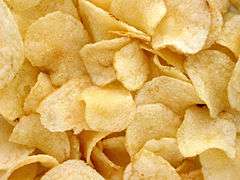 | |
| Alternative names | Crisps |
|---|---|
| Course | Snack, side dish |
| Place of origin | United Kingdom, 1817 |
| Serving temperature | Room temperature |
History
Origin
The earliest known recipe for something similar to today's potato chips is in William Kitchiner's book The Cook's Oracle published in 1817, which was a bestseller in the United Kingdom and the United States.[2] The 1822 edition's recipe for "Potatoes fried in Slices or Shavings" reads "peel large potatoes… cut them in shavings round and round, as you would peel a lemon; dry them well in a clean cloth, and fry them in lard or dripping".[3][4] An 1825 British book about French cookery calls them "Pommes de Terre frites" (second recipe) and calls for thin slices of potato fried in "clarified butter or goose dripping", drained and sprinkled with salt.[5] Early recipes for potato chips in the US are found in Mary Randolph's Virginia House-Wife (1824)[6] and in N.K.M. Lee's Cook's Own Book (1832),[7] both of which explicitly cite Kitchiner.[8]
Saratoga Springs legend
A legend associates the creation of potato chips with Saratoga Springs, New York decades later than the first recorded recipe.[9] By the late nineteenth century, a popular version of the story attributed the dish to George Crum, a cook[10][11] at Moon's Lake House who was trying to appease an unhappy customer on 24 August 1853.[12] The customer kept sending back his French-fried potatoes, complaining that they were too thick,[13] too "soggy", or not salted enough. Frustrated, Crum sliced several potatoes extremely thin, fried them to a crisp, and seasoned them with extra salt. To his surprise, the customer loved them. They soon came to be called "Saratoga Chips",[14] a name that persisted into the mid-twentieth century. A version of this story was popularized in a 1973 national advertising campaign by St. Regis Paper Company which manufactured packaging for chips, claiming that Crum's customer was Cornelius Vanderbilt.[10] Crum was already renowned as a chef at the time, and he owned a lakeside restaurant by 1860 which he called Crum's House.[10] The "Saratoga Chips" brand name still exists today.
Production
In the 20th century, potato chips spread beyond chef-cooked restaurant fare and began to be mass-produced for home consumption. The Dayton, Ohio-based Mikesell's Potato Chip Company, founded in 1910, identifies as the "oldest potato chip company in the United States".[15][16][17] New England-based Tri-Sum Potato Chips, founded in 1908 as the Leominster Potato Chip Company, in Leominster, Massachusetts, claims to be America's first potato chip manufacturer.[18][19]
Flavored chips
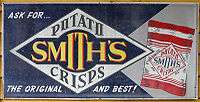
In an idea originated by the Smiths Potato Crisps Company Ltd, formed in 1920, Frank Smith packaged a twist of salt with his chips in greaseproof paper bags, which were sold around London.[20] The potato chip remained otherwise unseasoned until an innovation by Joe "Spud" Murphy, the owner of the Irish crisps company Tayto, who in the 1950s developed a technology to add seasoning during manufacture.[2] After some trial and error, Murphy and his employee Seamus Burke produced the world's first seasoned chips: Cheese & Onion and Salt & Vinegar.[21] Companies worldwide sought to buy the rights to Tayto's technique.[22]
The first flavored chips in the United States, barbecue flavor, were being manufactured and sold by 1954.[23][24][25] In 1958, Herr's was the first company to introduce barbecue-flavored potato chips in Pennsylvania.[26]
Potato chip bag
Chips sold in markets were usually sold in tins or scooped out of storefront glass bins and delivered by horse and wagon. Early potato chip bags were wax paper with the ends ironed or stapled together. At first, potato chips were packaged in barrels or tins, which left chips at the bottom stale and crumbled.
In the 1920s, Laura Scudder,[27][28][29] an entrepreneur in Monterey Park, California, started having her workers take home sheets of wax paper to iron into the form of bags, which were filled with chips at her factory the next day. This pioneering method reduced crumbling and kept the chips fresh and crisp longer. This innovation, along with the invention of cellophane, allowed potato chips to become a mass-market product. Today, chips are packaged in plastic bags, with nitrogen gas blown in prior to sealing to lengthen shelf life, and provide protection against crushing.[30][31]
Kettle-cooked
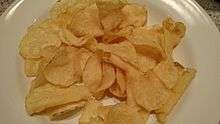
Chips were long made in a batch process, where the potato slices are rinsed with cold water to release starch,[32] fried at a low temperature (300 °F (150 °C)),[33] and continuously raked to prevent them from sticking together.
Industrial advances resulted in a shift to production by a continuous process, running chips through a vat of hot oil and drying them in a conveyor process.
Some small producers continued to use a batch process, notably in Maui.[34] In 1980, inspired by the Maui Chip, an entrepreneur started Cape Cod Potato Chips to produce thicker, batch-cooked "Hawaiian style" potato chips, which came to be known as kettle-style (US) or hand-cooked (UK) chips and became a premium, "gourmet" item.[35] Kettle chips are thicker and the surface starch is not rinsed off, resulting in a style of chip called "hard bite".[36]
Nomenclature
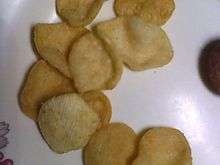
Little consistency exists in the English-speaking world for the name of this food. North American English uses "chips", though Canadians may also call French fries, especially thick ones, "chips" as well. "Crisps" may be used for thin fried potatoes made from batter.
In the United Kingdom and Ireland, "crisps" are potato chips which are eaten at room temperature, whilst "chips" are similar to french fries (as in "fish and chips") and are served hot.[37] In Australia, some parts of South Africa, New Zealand, India, the general West Indies especially in Barbados, both forms of potato product are simply known as "chips", as are the larger "home-style" variety. In the north of New Zealand, they are known as "chippies", but are marketed as "chips" throughout the country. In Australia and New Zealand, sometimes the distinction is made between "hot chips" (fried potatoes) and "chips" or "potato chips". In Bangladesh, they are generally known as "chip" or "chips", and much less frequently as "crisps" (pronounced "kirisp") and locally, alu bhaja (for their similarity to the fried potato dish, bhajji).
In German-speaking countries (Austria, Germany: "Kartoffelchips"; Switzerland: "Pommes Chips") and in countries of the former SFR Yugoslavia, fried thin potato slices are known as "chips" (locally pronounced very similar to the actual English pronunciation), with a clear distinction from french fries. In Brazil, "home-style" potato chips are known as batatas portuguesas ("Portuguese potatoes") if their sides are relatively smooth and batatas prussianas ("Prussian potatoes") if their sides show a wafer biscuit-like pattern, whilst American-like industrial uniform potato chips made from a fried potato purée-based dough are known as "batata chips" ("potato chips"), or just "chips".
Health concerns
Most potato chips contain high levels of sodium, from salt. This has been linked to health issues such as high blood pressure.[38] However, researchers at Queen Mary University of London in 2004 have noted that a small "bag of ready-salted crisps" contains less salt than a serving of many breakfast cereals, including "every brand of cornflakes on sale in the UK."[39]
Some potato chip companies have responded to the long-standing concerns by investing in research and development to modify existing recipes and create health-conscious products. PepsiCo research shows that about 80% of salt on chips is not sensed by the tongue before being swallowed. Frito-Lay spent $414 million in 2009 on product development, including development of salt crystals that would reduce the salt content of Lay's potato chips without adversely affecting flavor.[40]
Unsalted chips are available, e.g. the longstanding British brand Salt 'n' Shake, whose chips are not seasoned, but instead include a small salt sachet in the bag for seasoning to taste. Many other popular brands in the United States, such as Frito-Lay, also offer such a product.
Another possible health concern related to potato chips is acrylamide, which is produced when potatoes are fried or baked at high temperatures. Studies show that laboratory animals exposed to high levels of acrylamide develop cancer;[41] however, it is currently unclear whether a similar risk exists in humans. In August 2008, California Attorney General Jerry Brown announced a settlement with Frito-Lay, Kettle Foods, and Lance Inc. the makers of Cape Cod Potato Chips for violating the state's Safe Drinking Water and Toxic Enforcement Act. The state had alleged in 2005 that potato chips from these companies failed to document that they contained high levels of acrylamide, which is listed by California since the 1990s as a carcinogen. These companies paid fines and agreed to reduce acrylamide levels to be under 275 parts per billion.[42][43] Many potato chip manufacturers attempt to remove burned and thus potentially acrylamide-rich chips before the packaging process. Large scanners are used to eliminate chips worst affected by heat.[44]
Regional varieties
Canada
In Canada, seasonings include the unique all dressed, as well as dill pickle,[45] jalapeño, ketchup,[45][46] barbecue, sour cream and onion, and salt and vinegar. In 2006, Lay's introduced wasabi chips in Toronto and Vancouver,[47] but no longer offers them. Lays has recently released new Lay's Poppables which come in 3 flavours: Sea Salt and Vinegar, Honey BBQ, Sea Salt and White cheddar. [48] Loblaw, Canada's largest food retailer, offers several unusual flavors under its President's Choice brand, including poutine, maple bacon, Jamaican jerk chicken, Greek feta and olive, ballpark hot dog, and barbecue baby back ribs.[49]
Hong Kong
In Hong Kong, the two prominent potato chips are the spicy "Ethnican" variety by Calbee,[50] and barbecue by Jack 'n Jill. Lay's are also popular in Hong Kong.
Indonesia
In Indonesia, potato chips are commonly called as kripik kentang, traditionally fell under kripik category. Indonesian potato chips market is mainly ruled by two brands; Indofood's Chitato (since 1990s)[51] and Lay's (Frito-Lay). In 2014, Japan's Calbee and Indonesia's Wings Food formed Calbeewings, a joint venture and marketed Potabee potato chips in Indonesia.
Common potato chips flavors marketed in Indonesia include beef barbecue, spicy chicken, cheese and plain salted. Lay's potato chips sold in Indonesia is available in 6 flavors; honey butter, sour cream and onion, nori seaweed, beef barbecue, classic salty, and salmon teriyaki flavors.[52] Potabee sold in Indonesia offers two flavors; beef BBQ and grilled seaweed.[53] In 2018 Chitato launched "Do Us A Flavor" campaign that sell three unusual flavors; beef rendang, fried crab golden egg yolk, and mango sticky rice.[54]
Ireland
In Ireland, the two most popular flavors are cheese and onion, and salt and vinegar. However in Ireland, the word "Tayto" is synonymous with potato chips after the Tayto brand and can be used to describe all varieties of chips, including those not produced by Tayto.[55] Hunky Dorys and King are other popular Irish brands. In November 2010, the Tayto company opened a theme park called "Tayto Park".[56]
Mainland western Europe
In Germany, Belgium and the Netherlands only two flavors were traditionally available, red paprika (Paprika, sometimes also called ungarisch (from "Hungarian")) and salted (gesalzen). These are still by far the most common and popular types, but some vendors started to offer a number of other flavors such as sour cream and onion, cheese, oriental, or more exotic seasonings like "Chakalaka", "Currywurst", "Pommes" (french fries), "Rot-weiss" (red and white - french fries with tomato ketchup and mayonnaise). Potato chips made from ground potatoes are called Stapelchips rather than Kartoffelchips for legal reasons.
Colombia
In Colombia, lemon, chicken, chorizo, and sirloin steak with mushroom sauce flavored potato chips are sold.[57]
Japan
In Japan, flavors include norishio (nori and salt), consommé, wasabi, soy sauce and butter, garlic, plum, barbecue, pizza, mayonnaise, and black pepper. Chili, scallop with butter, teriyaki, takoyaki, and yakitori chip flavors are also available. Major manufacturers are Calbee,[58] Koikeya[59] and Yamayoshi.
United Kingdom
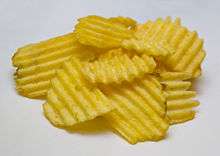
The market in the United Kingdom is led by Walkers, which held 56% of the British crisp market in 2013.[60] Walkers is known for its wide variety of crisps with the most popular flavours being Cheese & Onion, Salt & Vinegar, Prawn Cocktail, Beef and Onion, Roast Chicken, Smoky Bacon, Worcester Sauce, Pickled Onion, Tomato Ketchup, and Salt & Shake - Original.[61][62]
More exotic flavors are Thai sweet chili, roast pork and creamy mustard sauce, lime and Thai spices, chicken with Italian herbs, Spicy Sriracha, BBQ Pulled Pork, sea salt and cracked black pepper, sea salt and cider vinegar, spicy and aromatic curry, turkey and bacon, caramelized onion and sweet balsamic vinegar, Stilton and cranberry.[62] Since 2008, Walkers has launched its "Do Us a Flavour" campaign, challenging the British public to think up unique flavours for their crisps. Six flavours were chosen from among the entries and released as special editions.[63] In 2014 the public had to pick one of Walkers' base ingredients, which was made up of six flavours from around the UK – Somerset Cheddar, Devonshire Chicken, Norfolk Pork, Dorset Sour Cream, Vale of Evesham Tomatoes and Aberdeen Angus Beef – then add their own unique flavour.[64] In 2018 Walkers launched six new flavours to celebrate the brand’s 70th birthday, with each flavour representing a different decade.[61]
In 1981, hedgehog flavoured crisps were produced by the landlord of The Vaults in Welshpool, Philip Lewis, for his customers who kept asking for them as a joke. They became unexpectedly popular but this then led to controversy. There was concern that real hedgehogs were being slaughtered but it proved that they were actually flavoured with pork fat. This then caused concern about false advertising and so a compromise was agreed with the trading standards authorities– the labelling was amended to "Hedgehog® Flavoured Crisps".[65][66][67]
United States
In the United States, potato chips are made by national chains like Frito-Lay, Pringles and Kettle Brand; major regional brands like Jay's of Chicago, Better Made of Detroit and Old Dutch of Minneapolis; and specialty brands with local or uneven distribution.
Potato chip flavorings include variations of barbecue, as well as sour cream and onion, sour cream and cheddar, salt and vinegar, ranch, jalapeno and cheese.[68] "Hot" is a common flavor such as Jay's Hot Stuff and Better Made Red Hot. Better Made also make Rainbow chips, heavily cooked dark-colored chips which would be rejected by most processors. In the Gulf South, Zapp's of Gramercy, Louisiana, makes kettle-cooked chips using regional flavors such as Crawtator, Cajun dill, Voodoo, and Creole onion.[69]
Pennsylvania
Pennsylvania leads the United States in potato chip production, and has been dubbed "the Potato Chip Capital" by several sources.[70] Pennsylvania-based companies that produce potato chips include Utz Quality Foods, Herr's Snacks, Snyder's of Berlin, Snyder's of Hanover, Martin's Potato Chips, Wise Foods, Middleswarth Potato Chips,[71] Dieffenbach's Potato Chips,[72] Hartley's Potato Chips,[73] Gibbles Foods,[74] Stehman's Potato Chips, and Charles Chips. Many of these companies are members of SNAC International, the global snack industry association.
Similar foods
Another type of potato chip, notably the Pringles and Lay's Stax brands, is made by extruding or pressing a dough made from dehydrated potatoes into the desired shape before frying. This makes chips that are uniform in size and shape, which allows them to be stacked and packaged in rigid cardboard or plastic canisters. Pringles are officially branded as "potato crisps" in the US. Pringles may be termed "potato chips" in Britain, to distinguish them from traditional "crisps". Munchos, another brand that uses the term "potato crisps", has deep air pockets in its chips that give it a curved shape, though the chips themselves resemble regular bagged chips.
An additional variant of potato chips exists in the form of "potato sticks", also called "shoestring potatoes". These are made as extremely thin (2 to 3 mm) versions of the popular French fry but are fried in the manner of regular salted potato chips. A hickory-smoke-flavored version is popular in Canada, going by the vending machine name "Hickory Sticks". Potato sticks are typically packaged in rigid containers, although some manufacturers use flexible pouches, similar to potato chip bags. Potato sticks were originally packed in hermetically sealed steel cans. In the 1960s, manufacturers switched to the less expensive composite canister (similar to the Pringles container). Reckitt Benckiser was a market leader in this category under the Durkee Potato Stix and French's Potato Sticks names but exited the business in 2008. In 2014, French's reentered the market.
A larger variant (about 1 cm thick) made with dehydrated potatoes is marketed as Andy Capp's Pub Fries, using the theme of a long-running British comic strip, which are baked and sold in a variety of flavors. Walkers make a similar product (using the Smiths brand) called "Chipsticks" which are sold in ready-salted and salt and vinegar flavors.
Some companies have also marketed baked potato chips as an alternative with lower fat content. Additionally, some varieties of fat-free chips have been made using artificial, and indigestible, fat substitutes. These became well known in the media when an ingredient many contained, Olestra, was linked in some individuals to abdominal discomfort and loose stools.[75]
Many other products might be called "crisps" in Britain, but would not be classed as "potato chips" because they are not made with potato or are not chipped (for example, Wotsits, Quavers, Skips, Hula Hoops, and Monster Munch).
Sweet potato chips are eaten in Korea, New Zealand, and Japan; parsnip, beetroot, and carrot crisps are available in the United Kingdom. India is famous for a large number of localized 'chips shops', selling not only potato chips, but also other varieties such as plantain chips, tapioca chips, yam chips, and even carrot chips. Plantain chips, also known as chifles or tostones, are also sold in the Western Hemisphere from Canada to Chile. In the Philippines, banana chips can be found sold at local stores. In Kenya, chips are made from arrowroot and casava. In the United Kingdom, Sweden, Finland, and Australia, a new variety of Pringles made from rice has been released and marketed as lower in fat than its potato counterparts.[76]
Production
- Process of making chips
- Potato is sliced by rotating the blade
- Long and narrow slices are produced
- The potato slices are fried in hot oil
- Frying takes several minutes
- Finished product
See also
- George Crum
- Chips and dip
- List of deep fried foods
- List of potato dishes
- Papadum
- Vegetable chips
References
- "PotatoPro/Datamonitor". Potatopro.com. Archived from the original on 15 July 2011. Retrieved 26 May 2009.
- "Did Tayto really invent cheese and onion crisps?". The Irish News. Retrieved 16 November 2019.
- Berry, Steve & Norman, Phil (14 July 2014). "'Crisps buoyed Britain in its darkest hour'". The Telegraph. Archived from the original on 3 October 2014. Retrieved 26 August 2014.
- Kitchiner, William (1822). The Cook's Oracle: Containing Receipts for Plain Cookery on the Most ... A. Constable & Company, Edinburgh, and Hurst, Robinson & Company, Cheap-sid. p. 208. OCLC 3878292. Archived from the original on 15 November 2017.
Potatoes fried in Slices or Shavings
- An English Physician, French Domestic Cookery, London: Thomas Boys, 1825, recipe 692, p. 238
- Randolph, Mary (1838) [1824]. The Virginia Housewife: or Methodical Cook. Baltimore: John Plaskitt. p. 97. OCLC 57123160.
To Fry Sliced Potatos [sic]
- Lee, N.K.M. (A Boston Housekeeper) (1832). The Cook's Own Book: Being A Complete Culinary Encyclopedia: Comprehending All Valuable Receipts For Cooking Meat, Fish, And Fowl, And Composing Every Kind Of Soup, Gravy, Pastry, Preserves, Essences, &c. That Have Been Published Or Invented During The Last Twenty Years. Particularly The Very Best Of Those In The Cook's Oracle, Cook's Dictionary, And Other Systems Of Domestic Economy.Diamond Mb With Numerous Original Receipts, And a Complete System of Confectionery. Boston: Munroe and Francis; New York: Charles E. Francis and David Felt. p. 192. OCLC 56906530.
Potatoes Fried In Slices Or Ribbons
- McWilliams, Mark (2012). The Story Behind the Dish: Classic American Foods. ABC-CLIO. p. 186. ISBN 9780313385100. Archived from the original on 22 February 2014.
- Smith, Merril D. (2013). History of American Cooking. ABC-CLIO. p. 93. ISBN 9780313387111. Archived from the original on 15 April 2016.
- Fox, William S. & Banner, Mae G. (April 1983). "Social and Economic Contexts of Folklore Variants: The Case of Potato Chip Legends". Western Folklore. 42 (2): 114–126. JSTOR 1499968.
- Upton, Kim (3 July 2003). "Any Way You Slice It, Potato Chip's Going Strong After 150 Years". Fort Lauderdale Sun Sentinel. Archived from the original on 25 December 2014.
- Henley, Jon (1 September 2010). "Crisps: a very British habit | Life and style". The Guardian. Archived from the original on 25 July 2014. Retrieved 26 August 2014.
- "George Crum: Inventor of Potato Chips". Black-inventor.com. Archived from the original on 6 January 2014. Retrieved 13 January 2014.
- "Civil War Recipes and Food History - The Potato During the Civil War". Civilwarinteractive.com. Archived from the original on 22 October 2014. Retrieved 11 May 2013.
- "About Us". Mike-sell's. Archived from the original on 25 June 2009. Retrieved 26 May 2009.
- Katz, Marc (16 May 2010). "Mike-Sell's celebrating 100 years of potato chips; The company could be the oldest continuous potato chip operation in world". Dayton Daily News. Archived from the original on 3 November 2013.
- Cogliano, Joe (14 May 2012). "Mike-sell's names new CEO". Dayton Business Journal. Archived from the original on 24 December 2014.
- Harmon, John E. "Potato Chips". Atlas of Popular Culture in the Northeastern US. Archived from the original on 20 February 2011. Retrieved 31 December 2014.
- Radvon, Erik (17 October 2008). "Tri-Sum Chips celebrates 100 years: Leominster staple is oldest surviving potato chip in America". Leominster Champion. Archived from the original on 25 December 2014.
- "BBC h2g2 Potato Crisps - A History". BBC. 7 December 2006. Archived from the original on 17 August 2009. Retrieved 26 May 2009.
- "Joe 'Spud' Murphy: The Man Who Gave Potato Chips Flavor". Huffington Post. 20 April 2012. Archived from the original on 31 October 2014.
- Hochman, Karen. "A History of the Potato Chip: Page 4: The First Salted & Flavored Potato Chips". The Nibble. Archived from the original on 22 December 2015.
- Pease, Sue (5 August 2002). "Lays flavor is chip off the Memphis barbecue block". Memphis Daily News. Archived from the original on 25 January 2015.
- Atwood, Liz (2 July 2003). "Palate-pleasing Chips: Snack Phenomenon Comes In All Flavors, Shapes And Colors". Newport News Daily Press. Archived from the original on 23 January 2015.
- Martin, Chuck (18 June 2003). "Ohio cashes in on chips". Cincinnati Enquirer.
- Weaver, Kyle R. (Summer 2012). "Snackin' - Pennsylvania Style!". Pennsylvania Heritage Magazine. XXXIII (3). Archived from the original on 22 August 2015.
- "Our History". Laura Scudder's. 17 September 2008. Archived from the original on 17 September 2008. Retrieved 11 May 2013.
- Hudson, Berkley (9 April 1989). "Laura Scudder Was More Than a Name: Monterey Park Will Honor 'Pioneer, Instigator, Doer' Who Helped Create Snack-Food Industry". Los Angeles Times. Archived from the original on 6 November 2013.
- La Ganga, Maria L. (23 September 1987). "Laura Scudder Owed a Lot to Peanut Butter". Los Angeles Times. Archived from the original on 28 September 2015.
- "The History and Origin of Potato Chips". Students.cup.edu. Archived from the original on 27 January 2010. Retrieved 3 August 2010.
- Singh, Maanvi (24 July 2014). "The Weird, Underappreciated World Of Plastic Packaging". NPR. Archived from the original on 28 July 2014. Retrieved 29 July 2014.
- Serious Eats. "The Food Lab: Extra-Crunchy Homemade Potato Chips". seriouseats.com. Archived from the original on 28 March 2017. Retrieved 1 May 2017.
- Roman, Alison (October 2014). "Crispiest Potato Chip". Bon Appétit. Archived from the original on 5 May 2017. Retrieved 1 May 2017.
- Malabar Hornblower, "Fare of the Country: Potato Chips With Hawaiian Crunch", New York Times 12 July 1987, p. 12 full text
- "Cape Cod Potato Chips: A 'Luxury' Junk Food", New York Times, 26 December 1986, p. D1 full text
- Kim Severson, "The Best Chip? The First One Out of the Bag", New York Times 4 July 2007 full text
- "Chips or fries or crisps?". Oxford Dictionaries. Retrieved 11 January 2019.
- Rothstein, William G. (2003). Public Health and the Risk Factor: A History of an Uneven Medical Revolution. Boydell & Brewer. ISBN 9781580461276.
- "Health hazard hidden in breakfast bowls". Action on Salt. Queen Mary University of London. 12 November 2004. Archived from the original on 7 November 2012.
- McKay, Betsy (22 March 2010). "PepsiCo Develops 'Designer Salt' to Chip Away at Sodium Intake". Wall Street Journal. Archived from the original on 23 December 2014. Retrieved 22 March 2010.
- "Acrylamide"
- "Atty. Gen. Brown Settles Potato Chip Lawsuit With Heinz, Frito-Lay & Kettle Foods". Press Release. State of California. 1 August 2008. Retrieved 28 October 2011.
Under today's settlements, Frito-Lay, Inc., which sells most of the potato chips sold in California, Kettle Foods, Inc., maker of "Kettle Chips", and Lance, Inc., maker of Cape Cod Chips will reduce acrylamide over a period of three years to 275 parts per billion. For Frito Lay, this is about a 20% reduction, while for Kettle Chips, which contain far more acrylamide, this is an 87% reduction in acrylamide.
- Lazarus, David (6 August 2008). "A stone wall made of potato chips". Consumer Confidential. Los Angeles Times. Retrieved 28 October 2011.
- “Warning over 'burnt toast chemical' acrylamide's cancer risk”. NHS. Retrieved 8 July 2019
- "Martin Short partners with the Lay's® brand and invites Canadians to create the brand's next big flavour" (Press release). PepsiCo Canada. 4 February 2013. Archived from the original on 22 January 2015.
- Weisblott, Marc (3 June 2013). "The mystery of the history of ketchup chips in Canada". Postmedia News. Archived from the original on 22 January 2015.
- Hoffman, Andy (21 February 2006). "Frito Lay perks up chips". The Globe and Mail. Archived from the original on 4 March 2016.
- "Lay's Canadian website". Archived from the original on 31 October 2012. Retrieved 21 October 2012.
- "PC World of Flavours Maple Bacon Potato Chips". Maxi (Canadian supermarket). Archived from the original on 14 July 2015.
- "Calbee Four Seas Co. Ltd". Archived from the original on 24 August 2008. Retrieved 24 August 2008.
- ronnzemo. "Yuk Kita Lihat Sejarah dan Perubahan Chitato Dari Dulu Hingga Sekarang". KASKUS (in Indonesian). Retrieved 27 February 2018.
- "Lays". www.indofood.com. Retrieved 27 February 2018.
- "Calbeewings". calbeewings.co.id. Retrieved 27 February 2018.
- Makmur, PT Indofood Sukses. "Chitato Do Us A Flavor". chitatodousaflavor.com. Retrieved 27 February 2018.
- O'Connell, Brian (6 June 2009). "Two packets of Tayto and a bottle of TK ..." The Irish Times.
- "Tayto Park - Theme Park & Zoo". www.taytopark.ie. Retrieved 22 March 2019.
- "Super Ricas Productos". Super Ricas. Archived from the original on 23 June 2015. Retrieved 15 June 2015.
- "Calbee カルビー株式会社". Calbee. Archived from the original on 4 June 2009. Retrieved 26 May 2009.
- "株式会社湖池屋|総合スナックメーカーのコイケヤ". Koikeya.co.jp. Archived from the original on 21 April 2009. Retrieved 26 May 2009.
- Briggs, Hannah (30 May 2013). "BBC Food: Crisps: Is classic potato losing its appeal?". BBC. Archived from the original on 23 February 2015. Retrieved 13 March 2015.
- "Walkers launches six new limited-edition crisp flavours to mark 70th anniversary". Independent. Retrieved 4 July 2019.
- "31 Wacky and Weird Flavors of British Potato Crisps". BBC America. Retrieved 4 July 2019.
- "Squirrel-flavoured crisps go on sale in UK". Metro.co.uk. 9 January 2008. Retrieved 26 January 2009.
- "Gary Lineker launches Walkers' new flavour campaign". Digital Spy. Retrieved 8 July 2019.
- Glyn Hughes (2017), The Lost Foods of England, p. 55, ISBN 9780244029630
- Glyn Mapes (2007), Herd on the Street: Animal Stories from The Wall Street Journal, Simon and Schuster, p. 75, ISBN 9781416583189
- "Hedgehog Crisps' Welshpool inventor dies, aged 74", Shropshire Star, 28 February 2017
- "LAY'S". Frito-Lay. Archived from the original on 29 May 2010. Retrieved 3 August 2010.
- "Zapp's Potato Chips". Zapps.com. Archived from the original on 2 January 2014. Retrieved 13 January 2014.
- Wohlsen, Marcus (4 July 2013). "The Secret Behind the Success of the Country's Potato Chip Capital". Wired. Archived from the original on 6 January 2017. Retrieved 29 January 2017.
- "Middleswarth Potato Chips". Archived from the original on 9 January 2017. Retrieved 29 January 2017.
- "Dieffenbachs Potato Chips - Experience the Delicious Difference!". Archived from the original on 3 February 2017. Retrieved 29 January 2017.
- "Hartleys Potato Chips". Archived from the original on 7 February 2017. Retrieved 29 January 2017.
- gibblesfoods.com/
- "New Fat-free Product on the Market". National Institute of Diabetes and Digestive and Kidney Diseases. Summer 1998. Archived from the original on 10 February 2009. Retrieved 26 May 2009.
- Olson, Elizabeth (1 July 2010). "Pringles Introduces a Multigrain Variety". The New York Times. ISSN 0362-4331. Retrieved 24 January 2019.
Further reading
- Banham, Rayner (1977) "The Crisp at the Crossroads", in P. Barker (ed) Arts in Society. London: Fontana.
- Jones, Charlotte Foltz (1991). Mistakes That Worked. Doubleday. ISBN 978-0-385-26246-0. – Origins of potato chips.
- Burhans, Dirk E. (2008). Crunch!: a history of the great American potato chip. University of Wisconsin Press. ISBN 9780299227708.
External links
| Look up potato chip in Wiktionary, the free dictionary. |
| Wikimedia Commons has media related to Potato chips. |